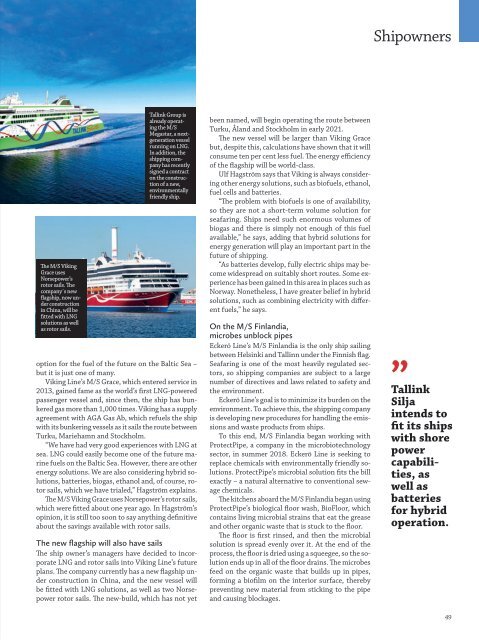Create successful ePaper yourself
Turn your PDF publications into a flip-book with our unique Google optimized e-Paper software.
Shipowners<br />
The M/S Viking<br />
Grace uses<br />
Norsepower’s<br />
rotor sails. The<br />
company´s new<br />
flagship, now under<br />
construction<br />
in China, will be<br />
fitted with LNG<br />
solutions as well<br />
as rotor sails.<br />
Tallink Group is<br />
already operating<br />
the M/S<br />
Megastar, a nextgeneration<br />
vessel<br />
running on LNG.<br />
In addition, the<br />
shipping company<br />
has recently<br />
signed a contract<br />
on the construction<br />
of a new,<br />
environmentally<br />
friendly ship.<br />
option for the fuel of the future on the Baltic Sea –<br />
but it is just one of many.<br />
Viking Line’s M/S Grace, which entered service in<br />
2013, gained fame as the world’s first LNG-powered<br />
passenger vessel and, since then, the ship has bunkered<br />
gas more than 1,000 times. Viking has a supply<br />
agreement with AGA Gas Ab, which refuels the ship<br />
with its bunkering vessels as it sails the route between<br />
Turku, Mariehamn and Stockholm.<br />
“We have had very good experiences with LNG at<br />
sea. LNG could easily become one of the future marine<br />
fuels on the Baltic Sea. However, there are other<br />
energy solutions. We are also considering hybrid solutions,<br />
batteries, biogas, ethanol and, of course, rotor<br />
sails, which we have trialed,” Hagström explains.<br />
The M/S Viking Grace uses Norsepower’s rotor sails,<br />
which were fitted about one year ago. In Hagström’s<br />
opinion, it is still too soon to say anything definitive<br />
about the savings available with rotor sails.<br />
The new flagship will also have sails<br />
The ship owner’s managers have decided to incorporate<br />
LNG and rotor sails into Viking Line’s future<br />
plans. The company currently has a new flagship under<br />
construction in China, and the new vessel will<br />
be fitted with LNG solutions, as well as two Norsepower<br />
rotor sails. The new-build, which has not yet<br />
been named, will begin operating the route between<br />
Turku, Åland and Stockholm in early 2021.<br />
The new vessel will be larger than Viking Grace<br />
but, despite this, calculations have shown that it will<br />
consume ten per cent less fuel. The energy efficiency<br />
of the flagship will be world-class.<br />
Ulf Hagström says that Viking is always considering<br />
other energy solutions, such as biofuels, ethanol,<br />
fuel cells and batteries.<br />
“The problem with biofuels is one of availability,<br />
so they are not a short-term volume solution for<br />
seafaring. Ships need such enormous volumes of<br />
biogas and there is simply not enough of this fuel<br />
available,” he says, adding that hybrid solutions for<br />
energy generation will play an important part in the<br />
future of shipping.<br />
“As batteries develop, fully electric ships may become<br />
widespread on suitably short routes. Some experience<br />
has been gained in this area in places such as<br />
Norway. Nonetheless, I have greater belief in hybrid<br />
solutions, such as combining electricity with different<br />
fuels,” he says.<br />
On the M/S Finlandia,<br />
microbes unblock pipes<br />
Eckerö Line’s M/S Finlandia is the only ship sailing<br />
between Helsinki and Tallinn under the <strong>Finnish</strong> flag.<br />
Seafaring is one of the most heavily regulated sectors,<br />
so shipping companies are subject to a large<br />
number of directives and laws related to safety and<br />
the environment.<br />
Eckerö Line’s goal is to minimize its burden on the<br />
environment. To achieve this, the shipping company<br />
is developing new procedures for handling the emissions<br />
and waste products from ships.<br />
To this end, M/S Finlandia began working with<br />
ProtectPipe, a company in the microbiotechnology<br />
sector, in summer 2018. Eckerö Line is seeking to<br />
replace chemicals with environmentally friendly solutions.<br />
ProtectPipe’s microbial solution fits the bill<br />
exactly – a natural alternative to conventional sewage<br />
chemicals.<br />
The kitchens aboard the M/S Finlandia began using<br />
ProtectPipe’s biological floor wash, BioFloor, which<br />
contains living microbial strains that eat the grease<br />
and other organic waste that is stuck to the floor.<br />
The floor is first rinsed, and then the microbial<br />
solution is spread evenly over it. At the end of the<br />
process, the floor is dried using a squeegee, so the solution<br />
ends up in all of the floor drains. The microbes<br />
feed on the organic waste that builds up in pipes,<br />
forming a biofilm on the interior surface, thereby<br />
preventing new material from sticking to the pipe<br />
and causing blockages.<br />
”<br />
Tallink<br />
Silja<br />
intends to<br />
fit its ships<br />
with shore<br />
power<br />
capabilities,<br />
as<br />
well as<br />
batteries<br />
for hybrid<br />
operation.<br />
49

















